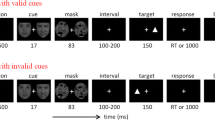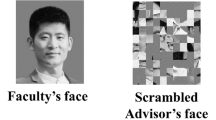Abstract
Numerous studies have suggested that threatening stimuli induce a spatial attention bias; however, only a few studies have investigated spatial attention biases for disgusting stimuli. Moreover, past studies generally reported that the spatial attention bias to disgusting images is not robustly in normal individuals. We hypothesized that this was due to the unfamiliar of the images, so we prepared the creature’s images that were clearly categorized as disgusting and examined the effects of disgusting images on spatial attention bias. A disgusting or an emotionally neutral image was paired and presented with an (emotionally neutral) filler image. After a temporal interval, a target appeared at either the position where a disgusting or a neutral image was presented (valid condition) or where a filler image was presented (invalid condition). Participants pressed a key corresponding to the target's position as quickly and accurately as possible. We varied the position-response correspondence among three experiments. The results showed that the RTs in the invalid condition was longer for the disgusting images than for the neutral images when the position of a disgusting image was not naturally associated with the left–right hand position. We interpreted the results in that that disgusting images generally slowed down attentional disengagement process but the manual responses were inhibited for the position where a disgusting image appeared when the locations of keys and targets were congruent. The present results suggest that disgusting images affect not only attentional processes but also manual responses related to the selection and initiation of responses.




Similar content being viewed by others
References
Anwyl-Irvine AL, Massonnié J, Flitton A, Kirkham N, Evershed JK (2020) Gorilla in our midst: an online behavioral experiment builder. Behav Res Methods 52(1):388–407
Bar-Haim Y, Lamy D, Pergamin L, Bakermans-Kranenburg MJ, Van Ijzendoorn MH (2007) Threat-related attentional bias in anxious and nonanxious individuals: a meta-analytic study. Psychol Bull 133(1):1–24
Carretié L (2014) Exogenous (automatic) attention to emotional stimuli: a review. Cogn Affect Behav Neurosci 14(4):1228–1258
Charash M, McKay D (2002) Attention bias for disgust. J Anxiety Disord 16(5):529–541
Charash M, McKay D, Dipaolo N (2006) Implicit attention bias for disgust. Anxiety Stress Coping 19(4):353–364
Cisler JM, Olatunji BO, Lohr JM, Williams NL (2009a) Attentional bias differences between fear and disgust: implications for the role of disgust in disgust-related anxiety disorders. Cogn Emot 23(4):675–687
Cisler JM, Bacon AK, Williams NL (2009b) Phenomenological characteristics of attentional biases towards threat: a critical review. Cogn Ther Res 33(2):221–234
Cisler JM, Olatunji BO (2010) Components of attentional biases in contamination fear: evidence for difficulty in disengagement. Behav Res Ther 48(1):74–78
Ciesielski BG, Armstrong T, Zald DH, Olatunji BO (2010) Emotion modulation of visual attention: categorical and temporal characteristics. PLoS ONE 5(11):e13860
Jeffreys H (1961) Theory of probability, 3rd edn. Oxford University Press, New York
Ledoux M (1996) Isoperimetry and Gaussian analysis. In: Lectures on probability theory and statistics (pp 165–294). Springer, Berlin, Heidelberg
Liu Y, Zhang D, Luo Y (2015) How disgust facilitates avoidance: an ERP study on attention modulation by threats. Soc Cognit Affect Neurosci 10:598–604
MacLeod C, Mathews A, Tata P (1986) Attentional bias in emotional disorders. J Abnorm Psychol 95(1):15–20
Neuberg SL, Kenrick DT, Schaller M (2011) Human threat management systems: self-protection and disease avoidance. Neurosci Biobehav Rev 35(4):1042–1051
Öhman A, Flykt A, Esteves F (2001) Emotion drives attention: detecting the snake in the grass. J Exp Psychol Gen 130(3):466–478
Olatunji BO, Haidt J, McKay D, David B (2008) Core, animal reminder, and contamination disgust: three kinds of disgust with distinct personality, behavioral, physiological, and clinical correlates. J Res Pers 42(5):1243–1259
Schmidt LJ, Belopolsky AV, Theeuwes J (2012) The presence of threat affects saccade trajectories. Vis Cogn 20(3):284–299
Shirai R, Watanabe K (2022) Open biological negative image set. R Soc Open Sci 9(1):211128
Van Hooff JC, Devue C, Vieweg PE, Theeuwes J (2013) Disgust-and not fear-evoking images hold our attention. Acta Physiol (Oxf) 143(1):1–6
Van Hooff JC, van Buuringen M, El M’rabet I, de Gier M, van Zalingen L (2014) Disgust-specific modulation of early attention processes. Acta Physiol (Oxf) 152:149–157
Van Rooijen R, Ploeger A, Kret ME (2017) The dot-probe task to measure emotional attention: a suitable measure in comparative studies? Psychon Bull Rev 24(6):1686–1717
Vogt J, Lozo L, Koster EH, De Houwer J (2011) On the role of goal relevance in emotional attention: disgust evokes early attention to cleanliness. Cogn Emot 25(3):466–477
Yiend J (2010) The effects of emotion on attention: a review of attentional processing of emotional information. Cogn Emot 24(1):3–47
Zhang D, Liu Y, Wang L, Ai H, Luo Y (2017) Mechanisms for attentional modulation by threatening emotions of fear, anger, and disgust. Cogn Affect Behav Neurosci 17(1):198–210
Zimmer U, Höfler M, Koschutnig K, Ischebeck A (2016) Neuronal interactions in areas of spatial attention reflect avoidance of disgust, but orienting to danger. NeuroImage 134:94–104
Acknowledgements
This work was supported by JSPS KAKENHI Grant Number JP20J00838 to RS; KAKENHI Grant Number 17H06344, 22H00090 to KW.
Author information
Authors and Affiliations
Corresponding author
Ethics declarations
Conflict of interests
We have no conflicts of interest to report regarding the finding of this study.
Ethics approval
This study was approved by the Ethics Review Committee on Research with Human Subjects at Waseda University.
Additional information
Publisher's Note
Springer Nature remains neutral with regard to jurisdictional claims in published maps and institutional affiliations.
Editors: Joanna Ganczarek (Pedagogical University of Cracow), Mario Dalmaso (University of Padova); Reviewers: Marta Zakrzewska (Karolinska Institute) and a second researcher who prefers to remain anonymous.
Electronic supplementary material
Below is the link to the electronic supplementary material.
Appendix
Appendix
List of images
Disgust: 1, 2, 4, 20, 23, 26, 30, 36, 38, 48; Neutral: 119, 173, 195, 199, 200, 170, 176, 179, 180, 168; Filler: 118, 114, 172, 194, 196, 117, 162, 174, 175, 193, 112, 115, 120, 121, 127, 158, 159, 171, 165, 163.
Rights and permissions
Springer Nature or its licensor (e.g. a society or other partner) holds exclusive rights to this article under a publishing agreement with the author(s) or other rightsholder(s); author self-archiving of the accepted manuscript version of this article is solely governed by the terms of such publishing agreement and applicable law.
About this article
Cite this article
Shirai, R., Watanabe, K. Visual images of disgusting creatures facilitated attentional orienting and delayed attentional disengagement. Cogn Process 25, 53–60 (2024). https://doi.org/10.1007/s10339-023-01162-0
Received:
Accepted:
Published:
Issue Date:
DOI: https://doi.org/10.1007/s10339-023-01162-0




